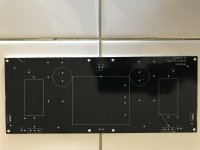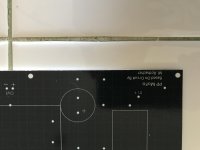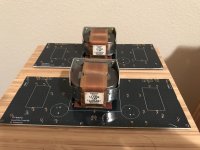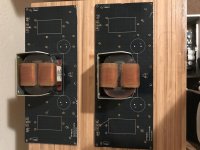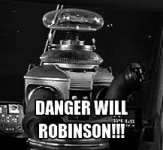When I recieved my chokes from AE I did measure them and the result wasn't okay . I mailed AE to ask if they made a mistake .They told me the chokes need to be tested and measured under load with a certain amount of DC and AC current .I used a L meter and this wasn't the correct way to do .
Last edited:
I have a pair of unused Panasonic HA 10000uf 63V caps left over from a previous project. Would these be a suitable substitute for the prescribed 6800uf caps. They measure approx 35mm x 50mm so should fit. Are there are cons/pros to going with an increase in capacitance at this point? Thanks Nigel.
I have a pair of unused Panasonic HA 10000uf 63V caps left over from a previous project. Would these be a suitable substitute for the prescribed 6800uf caps. They measure approx 35mm x 50mm so should fit. Are there are cons/pros to going with an increase in capacitance at this point? Thanks Nigel.
An output cap of 10mf is fine. In a lot of these type of amps even bigger caps are used. Nelson uses 22mf in some.
Sound quality is a bigger issue than the capacity I think. Bypassing is advised.
I can see that the measured frequency range is close to 200 kHz, but what was the driving impedance at the measurement?
I would like to use an autotransformer as gainstage before the MoFo, and keeping driving impedance as low as possible…
But perhaps the follower circuit bootstraps the Ciss to a lower value?
I would like to use an autotransformer as gainstage before the MoFo, and keeping driving impedance as low as possible…
But perhaps the follower circuit bootstraps the Ciss to a lower value?
I can see that the measured frequency range is close to 200 kHz, but what was the driving impedance at the measurement?
I would like to use an autotransformer as gainstage before the MoFo, and keeping driving impedance as low as possible…
But perhaps the follower circuit bootstraps the Ciss to a lower value?
See post 133. Driven with a low impedance.
@Aksa - thanks, good to know that it probably won’t affect the sound quality. Bass perception below 100Hz is not directional. As is, the amp reaches very nicely down to 10Hz as I recall.
X, can you show how you wire the MOT's you are using? The Hammonds only have (2) leads, pretty straightforward. But the MOT's have more. Which ones do use?
Official Thread Starter Note
I'd like to point out that this is a project that has some appeal for beginners, and for that reason, I DO NOT endorse the use of anything other than an inductor as described in the article, which can be purchased about as cheaply as any of the alternatives found here. I specifically do not endorse the use of microwave oven transformers or any high voltage transformer in this project.
If you are a more experienced builder who accepts the risks, understands the dangers of electricity, and knows how to protect yourself from them, then of course you can build anything you like.
You have been warned.

I'd like to point out that this is a project that has some appeal for beginners, and for that reason, I DO NOT endorse the use of anything other than an inductor as described in the article, which can be purchased about as cheaply as any of the alternatives found here. I specifically do not endorse the use of microwave oven transformers or any high voltage transformer in this project.
If you are a more experienced builder who accepts the risks, understands the dangers of electricity, and knows how to protect yourself from them, then of course you can build anything you like.
You have been warned.

Last edited:
X, can you show how you wire the MOT's you are using? The Hammonds only have (2) leads, pretty straightforward. But the MOT's have more. Which ones do use?
The primary coil has two terminals (not wires) visible near the bottom of the lower winding. The unused wires on the transformer are part of the light gauge secondary winding (taped off in the picture in post #393).
Thanks for the obligatory warning.
Last edited:
Yes, the two spade terminals connected to the big fatty solid magnet wire on the bottom is the primary. You don’t want to be anywhere near those secondaries as we discussed 10vac in the primary from audio signal can probably generate 200v in the secondaries. Hence, connectors are snipped off and wire ends are taped over.
But as above posts have warned us, do not use if you don’t know what you are doing. If you plug it into mains, this is what it is capable of.
YouTube
But as above posts have warned us, do not use if you don’t know what you are doing. If you plug it into mains, this is what it is capable of.
YouTube
Last edited:
PP MoFo
So I am attempting to make a differential amplifier from the MoFo circuit using the IRFP240 and IRFP9240 with a Lundahl choke. I originally wanted to make a push pull but decided against it. However I do like the name PP MoFo so I stuck with it.
So I am attempting to make a differential amplifier from the MoFo circuit using the IRFP240 and IRFP9240 with a Lundahl choke. I originally wanted to make a push pull but decided against it. However I do like the name PP MoFo so I stuck with it.
Attachments
Very niceSo I am attempting to make a differential amplifier from the MoFo circuit using the IRFP240 and IRFP9240 with a Lundahl choke. I originally wanted to make a push pull but decided against it. However I do like the name PP MoFo so I stuck with it.

Dangerous
For 25 euro/dollar you can buy a Hammond 159ZC. This one is powerful enough in most cases (rated at 60 mH at 2A, so most likely 50mH at 2.5A). I agree with Michael there is no financial gain in buying microwave parts.
The output voltage of these MOT's is a little above 2KV. For the USA with a 110V input. Driving these things with a 24V MoFo (approx 15VRMS) will still get you close to 300V. Not nice. People are using SMPS out of safety reasons and now use these transformers.
Then again: 300V is normal in any tube amp. As long as you know what you are doing. And remember 300V can be lethal. Not only for yourself. These voltages don't warn you. I have had my share of high voltages. But always within one hand/arm. I walked for weeks with 2 burned holes in my hand (one from the voltage going in, the other one from the spark going out). And this was caused by an OLD cap from a SMPS I took apart (that hadn't been used for some time). A couple of weeks ago I made a tiny mistake while working on an ESL. I touched the HV part in front of the safety resistor.
For 25 euro/dollar you can buy a Hammond 159ZC. This one is powerful enough in most cases (rated at 60 mH at 2A, so most likely 50mH at 2.5A). I agree with Michael there is no financial gain in buying microwave parts.
The output voltage of these MOT's is a little above 2KV. For the USA with a 110V input. Driving these things with a 24V MoFo (approx 15VRMS) will still get you close to 300V. Not nice. People are using SMPS out of safety reasons and now use these transformers.
Then again: 300V is normal in any tube amp. As long as you know what you are doing. And remember 300V can be lethal. Not only for yourself. These voltages don't warn you. I have had my share of high voltages. But always within one hand/arm. I walked for weeks with 2 burned holes in my hand (one from the voltage going in, the other one from the spark going out). And this was caused by an OLD cap from a SMPS I took apart (that hadn't been used for some time). A couple of weeks ago I made a tiny mistake while working on an ESL. I touched the HV part in front of the safety resistor.
I'm 100% in agreement with everyone when it comes to safety. There's no point in risking that kind of voltage being present on the secondaries of an MOT no matter how well you think you have sealed them off. Not to mention MOT's aren't the prettiest solution out there either. 
I'll save my pennies for some nice Hammonds and go the safe route.
I'll save my pennies for some nice Hammonds and go the safe route.
Your comment on ugly MOTs got me thinking............
The build guide says build monoblocks, because monoblocks are cool. I agree, but is this the only reason for that advice? I'm curious since I am planning on four channels total, and my heatsinks would work best in a more traditional chassis with two channels per side and their fins running vertically. It will also hide my beautiful MOTs!
Is it necessary to give any consideration to the choke locations in the chassis or shield them in some way (from each other, or anything else) due to closer proximity than would be the case with monoblocks?
The build guide says build monoblocks, because monoblocks are cool. I agree, but is this the only reason for that advice? I'm curious since I am planning on four channels total, and my heatsinks would work best in a more traditional chassis with two channels per side and their fins running vertically. It will also hide my beautiful MOTs!
Is it necessary to give any consideration to the choke locations in the chassis or shield them in some way (from each other, or anything else) due to closer proximity than would be the case with monoblocks?
- Home
- Amplifiers
- Pass Labs
- Build This MoFo!
